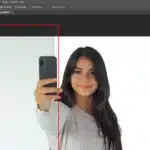
Editing wildlife photos in Lightroom is where your passion meets precision, transforming raw moments of nature into breathtaking works of art. Imagine capturing a leopard’s fierce gaze or a majestic eagle in flight, and then bringing those images to life with unparalleled clarity and impact. In this blog, we’ll explore the art and science of fine-tuning wildlife photos. Discover how to enhance exposure, sharpen intricate details, and perfect color temperature in photographs to highlight the true essence of your subjects.
Whether you’re an experienced wildlife photographer or just embarking on this exciting journey, these editing techniques will help you create stunning visuals that truly capture the wild’s majesty. Get ready to elevate your wildlife photography and let your images roar with life!
Table of Contents
Layered Adjustments: Editing Wildlife Photos in Lightroom
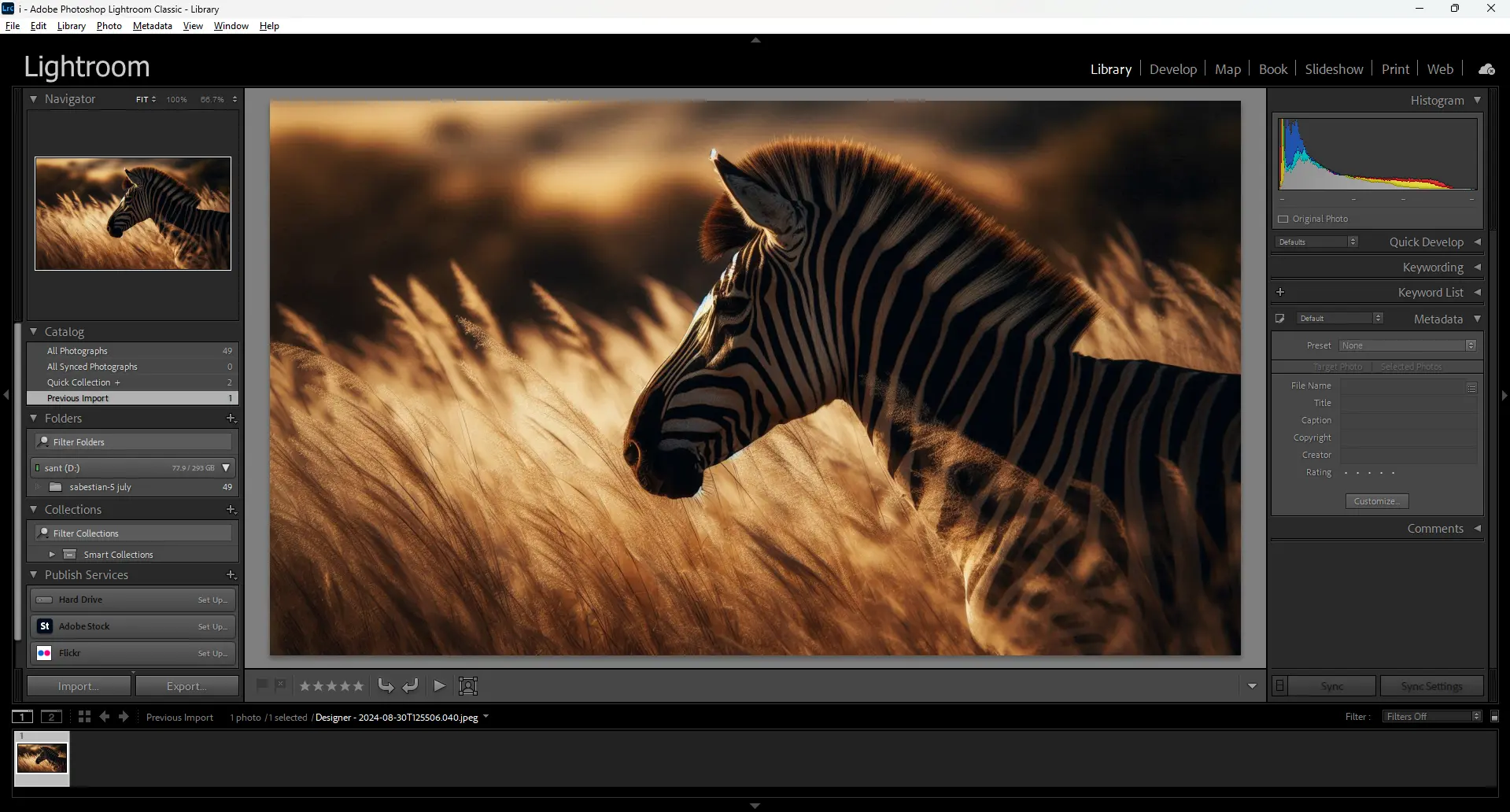
When it comes to edit wildlife photos, capturing stunning images in the field is just the beginning. The real magic often happens during post-processing, where Adobe Lightroom plays a critical role. Layered adjustments in Lightroom allow you to enhance your wildlife photos selectively, ensuring each part of the image is given the attention it deserves. Below, we’ll explore some of the most effective techniques to edit wildlife photos using Lightroom’s advanced tools.
Enhancing Details with Selective Sharpening
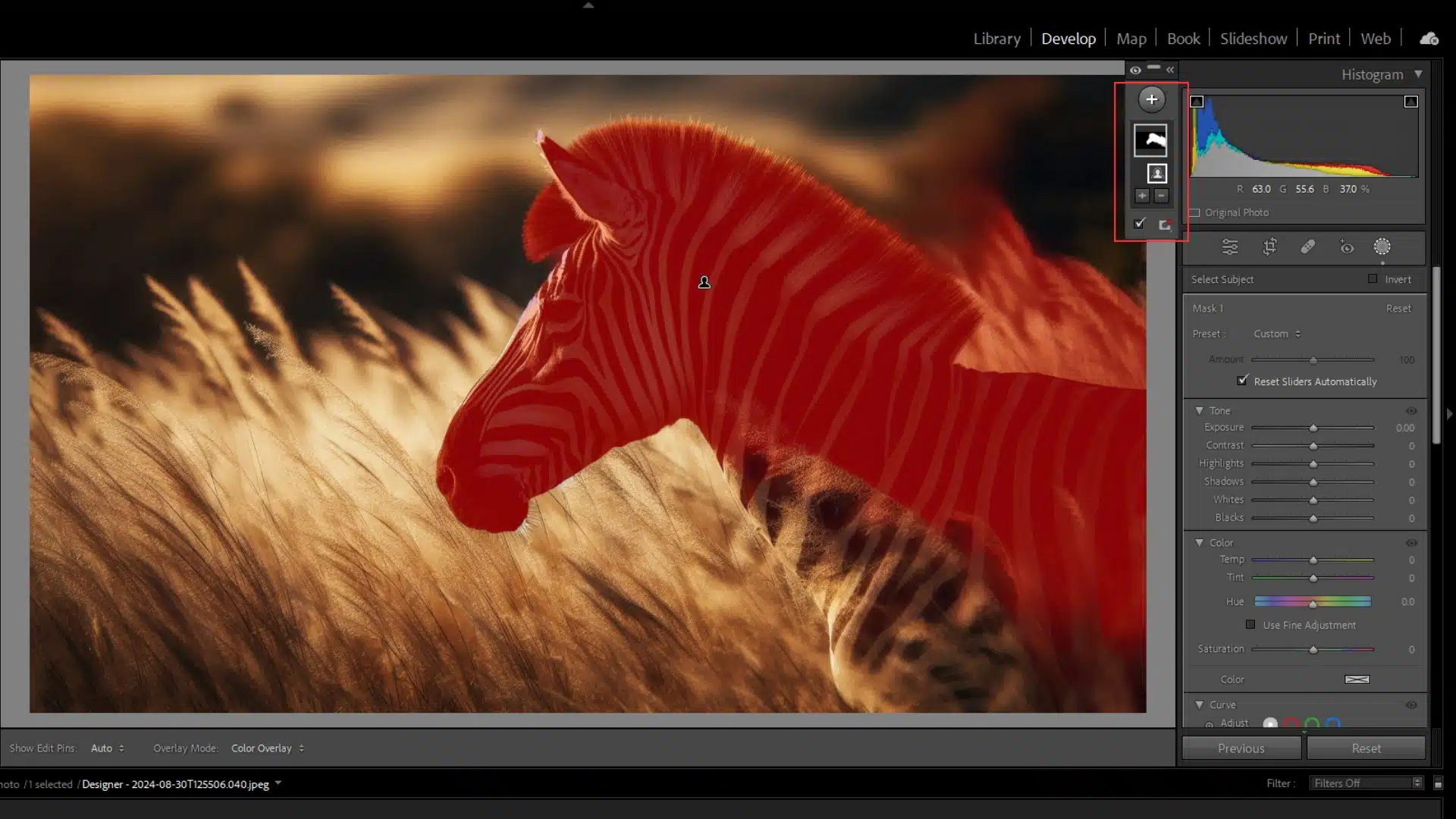
Selective sharpening is vital in wildlife photography to highlight the fine details, such as feathers, fur, or scales, without introducing unwanted noise.
- Start by setting Sharpening to Zero: Before applying any sharpening, set the sharpening amount to zero to avoid amplifying any default noise in the image. This gives you a clean slate to work from.
- Sharpening Sliders: Use the Radius slider carefully. A small radius works well for birds and small animals, whereas a larger radius might be better for larger mammals. Adjust the Detail slider to target fine textures like fur or feather but watch out for noise introduction.
- Masking: Use the Masking slider while holding the Alt/Option key to selectively apply sharpening only to the areas where it's needed, like the subject’s eyes or fur, without affecting the smooth areas like the sky or background.
Correcting Exposure and Enhancing Shadows
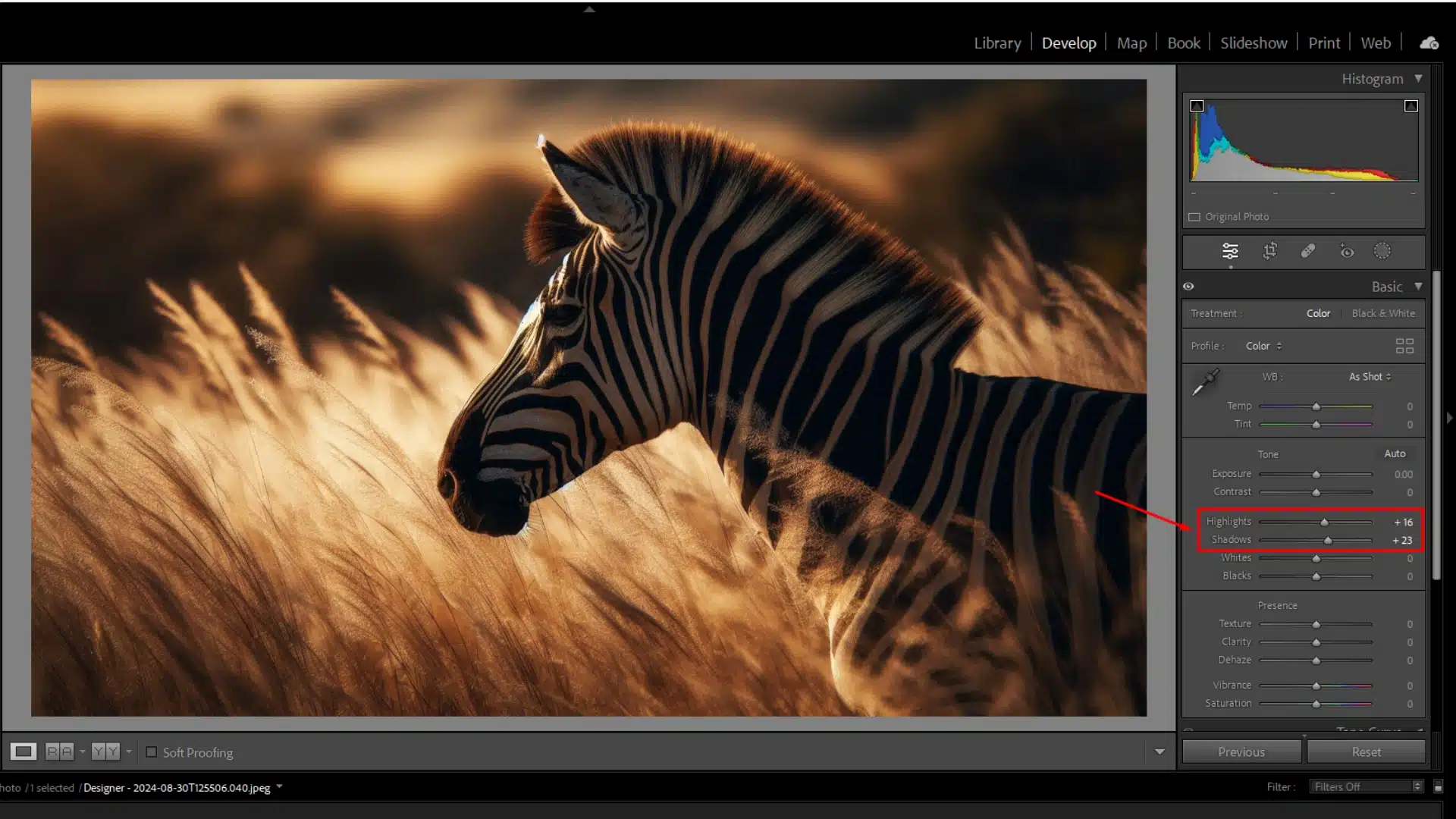
Wildlife photography often involves shooting in challenging lighting conditions, making gloom recovery and exposure adjustments crucial.
- Lift Shadows: To bring out details in the dark image, use the Shadows slider. This is especially useful when your subject is backlit or when you want to reveal more texture and more detail in shaded areas.
- Highlight Control: If parts of your image are too bright, especially when shooting in high-contrast situations, bring down the Highlights slider to recover blown-out areas, ensuring that the subject remains well-exposed without losing detail.
White Balance and Color Management
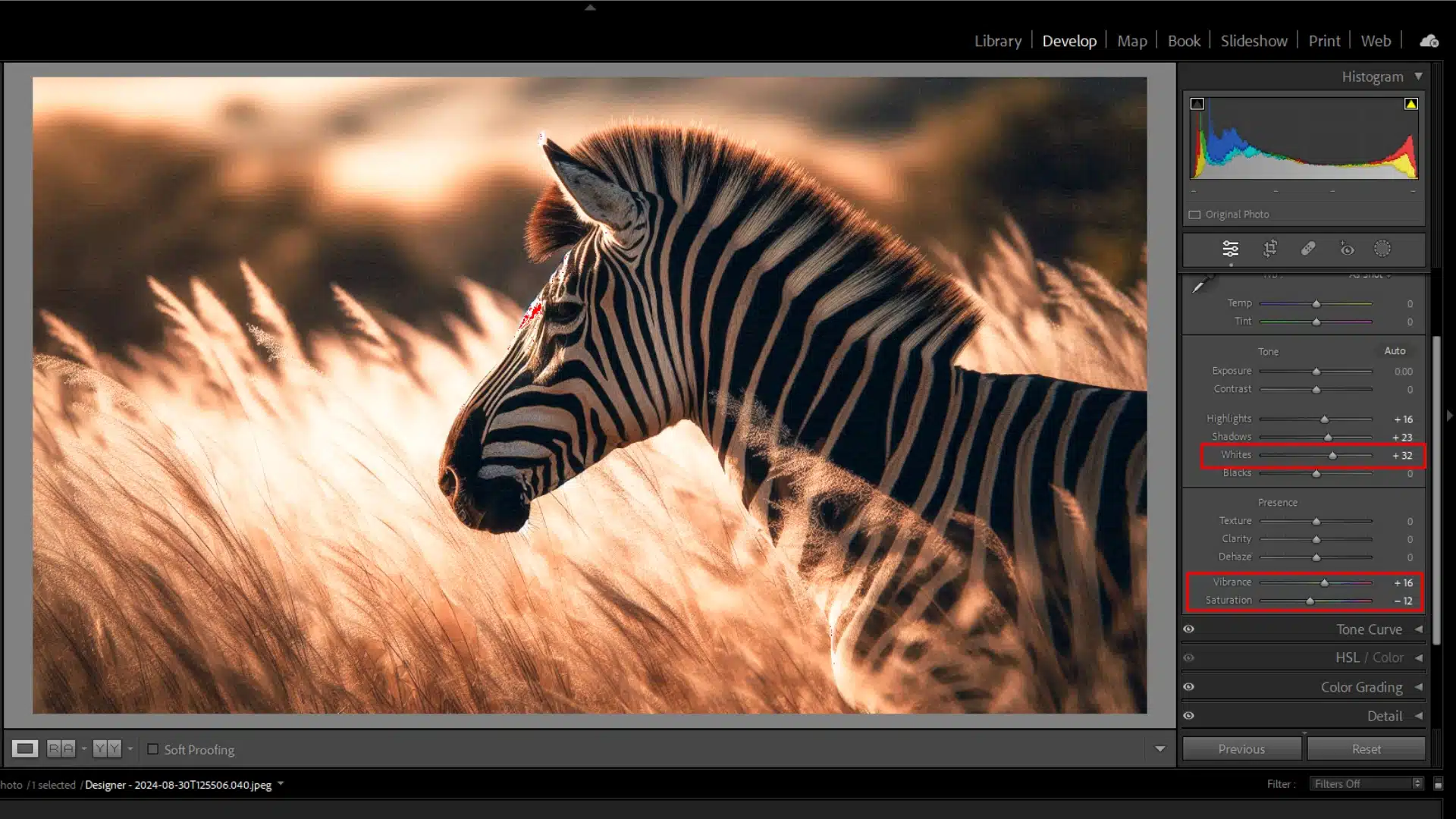
Getting the colors right is essential to edit wildlife photos.
- White Balance Adjustments: Start with a neutral preset like Daylight or Flash, depending on the lighting conditions, and fine-tune using the Temp and Tint sliders. This helps in achieving accurate colors, which is particularly important for maintaining the natural look of your wildlife shots.
- Vibrance and Saturation: To make the colors pop without oversaturating the image, gradually increase the Vibrance slider. This is especially useful for bringing out subtle colors in feathers or fur without affecting the overall balance.
Local Adjustments and Masking
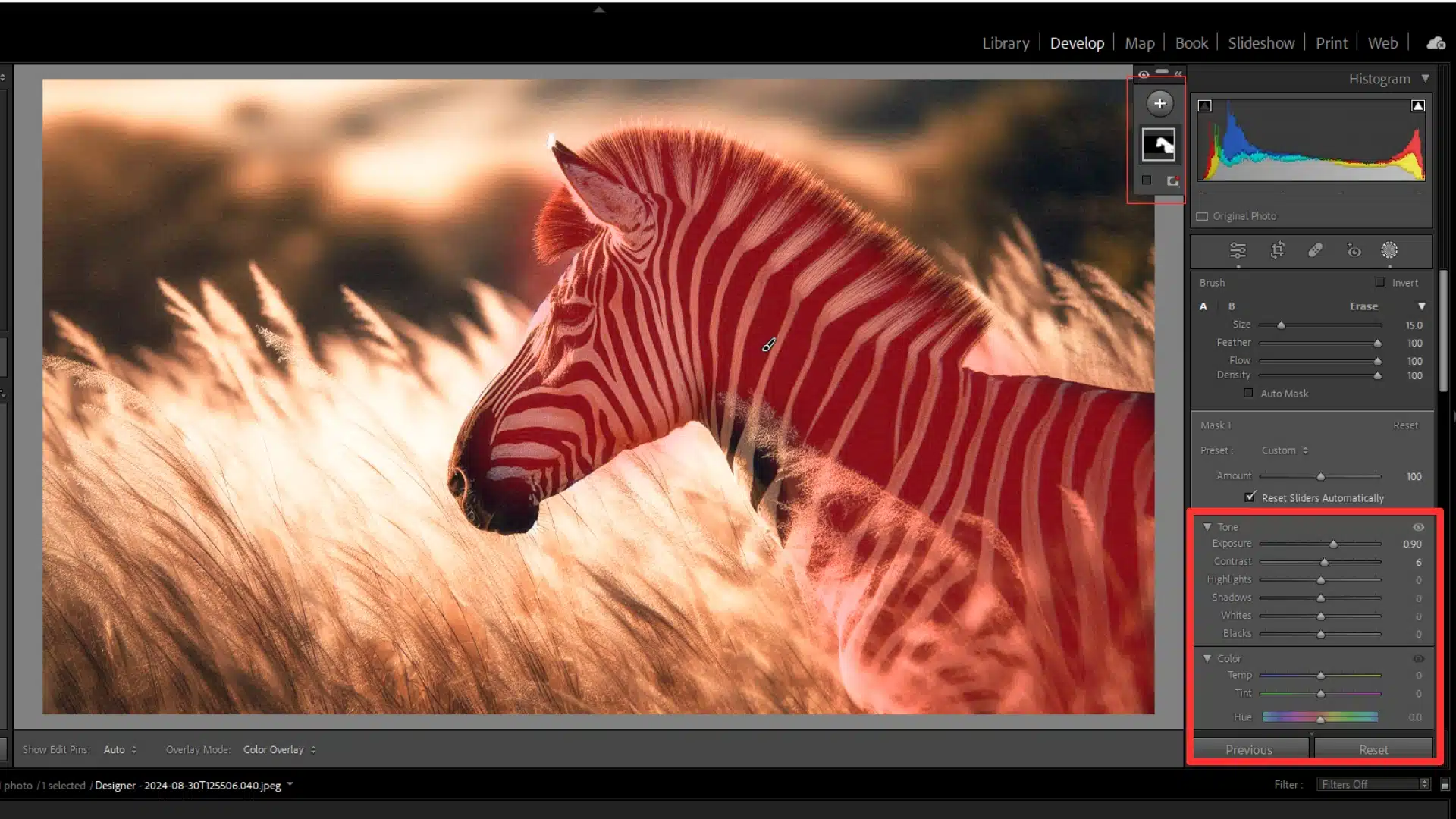
One of Lightroom’s most powerful features for wildlife photos is the ability to apply local adjustments using masks.
- Use the Adjustment Brush for Local Enhancements: Apply adjustments selectively to different parts of the image. For instance, you can boost the saturation of the target while reducing the vibrancy in the context to make the focus stand out more prominently.
- Object Selection Tool: If you need to isolate and enhance specific elements like a bird or an animal’s eye, use the Object Selection Tool in Lightroom to create precise masks. This allows you to apply effects like clarity adjustments only where needed, ensuring that the focus remains the focal point of the image.
Tilt-shift in Lightroom is another valuable technique that can add a unique, miniature effect to your wildlife photos. Applying the tilt-shift effect can help draw attention to your subject by blurring certain parts of the image while keeping the subject in sharp focus, mimicking the shallow depth of field often seen in macro photography.
Simplifying the Background
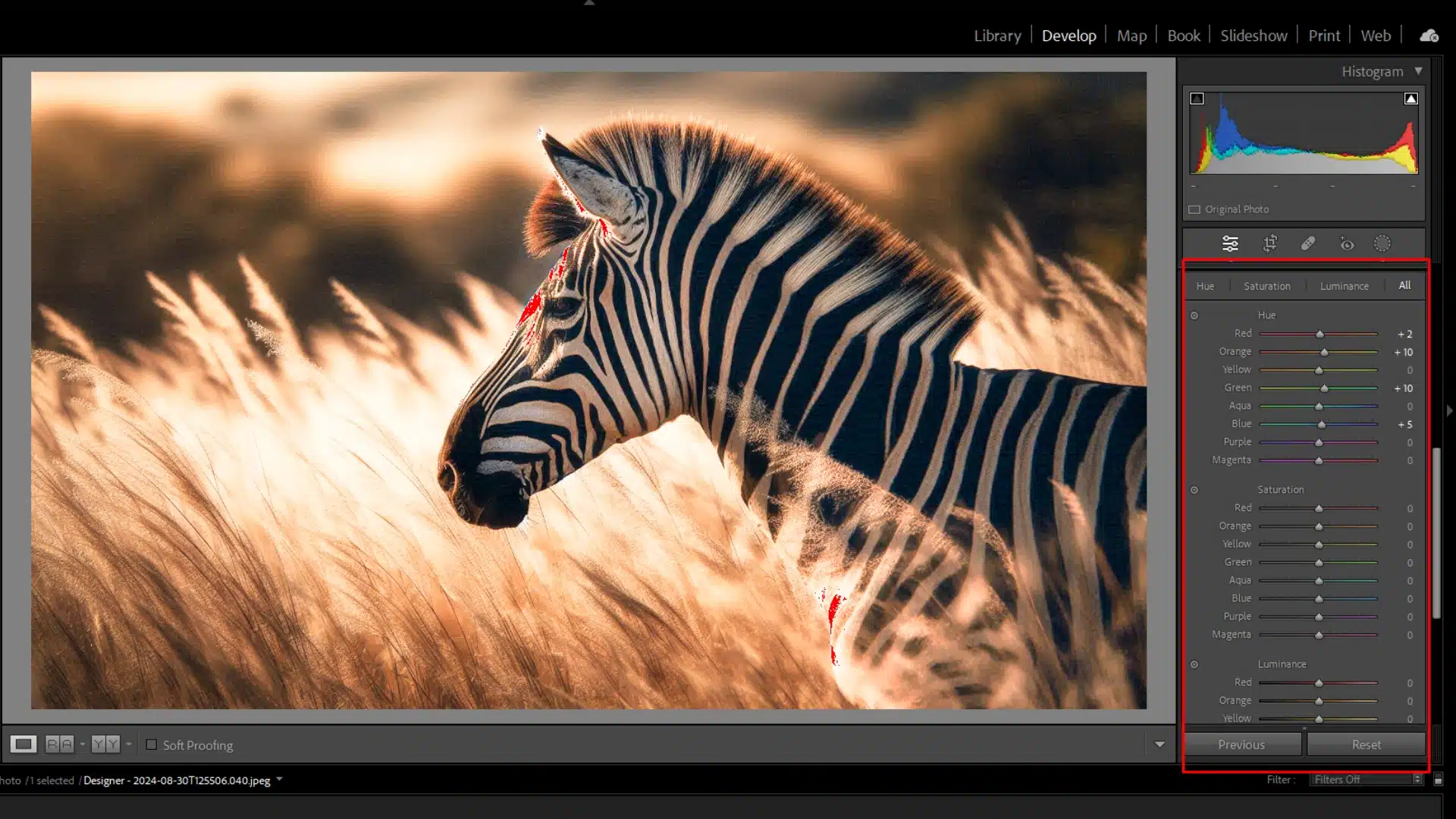
A busy background can detract from the main subject. Use the following techniques to keep the viewer’s attention where it belongs.
- Reduce Texture and Clarity: In the background, use the Adjustment Brush to decrease the Texture and Clarity sliders. This softens the backdrop, making the subject stand out more effectively.
- Color Control: Adjust the Hue/Saturation/Luminance (HSL) panel to desiderate or darken distracting colors in the backdrop, helping to simplify the scene and draw focus to your subject.
By utilizing these layered adjustments in Lightroom, you can significantly enhance your wildlife photos, transforming good shots into great ones. Whether you’re working on the sharpness of a bird’s feathers or remove the background to make an animal pop, these techniques provide the control needed to bring your vision to life.
Post-Processing Tips for Your Portfolio in Editing Wildlife Photos
Creating a stunning wildlife photography portfolio requires more than just capturing great shots in the field. The post-processing phase is where you can elevate your wildlife images, ensuring they are not only technically perfect but also visually impactful. Below are key tips for wildlife photography to make your portfolio-ready.
Start with the Basics: Culling and Initial Adjustments
Before diving into detailed edits, begin with a thorough culling process. This involves selecting the best shots based on sharpness, exposure, and composition. Use a star rating system to gradually narrow down your selection until only the most compelling wildlife images remain.
- Culling with AI Tools: Consider using AI-powered tools like After Shoot or Filter Pixel to speed up the culling process, though these are more common in portrait photography. The goal is to focus your time on pictures that have the most potential.
Fine-Tuning Exposure and White Balance
- Before diving into detailed edits, begin with a thorough culling process. This involves selecting the best shots based on sharpness, exposure, and composition. Use a star rating system to gradually narrow down your selection until only the most compelling wildlife images remain.
Exposure Adjustments
- Use the Exposure, Highlights, and Shadows sliders in Lightroom to balance the natural light in your pictures. This is particularly important for snaps shot in challenging lighting conditions, such as harsh sunlight or deep shadows.
White Balance
- Adjust the auto white balance to enhance the natural look of the scene. If you’re shooting during golden hour or in snowy conditions, tweak the temperature and tint to ensure that the colors are warm and natural.
Local Adjustments: Enhancing the Subject
Wildlife photos often benefit from local adjustments that help the subject stand out.
- Selective Sharpening: Apply sharpening selectively to emphasize the subject's details, such as the fur, feathers, or scales, without affecting the entire image. Use masking tools to apply sharpening only where it enhances the image.
- Background Simplification: Use these lightroom essential tools like to reduce clarity and surface in the background, making the subject more prominent. This technique helps eliminate distractions and keeps the viewer's focus on the main subject.
Advanced Techniques: Using Layers and Masks
For more complex edits, consider using layers and masks in Photoshop after your initial Lightroom adjustments.
- Smart Objects: When moving from Lightroom to Photoshop, convert your wildlife image into a Smart Object. This allows you to make non-destructive edits and keep your options open for future adjustments. Using smart object in Photoshop is crucial for preserving the quality and flexibility of your edits.
- Creative Effects: Experiment with creative effects like black-and-white conversion or selective color to add variety to your portfolio. Black-and-white images, in particular, can highlight texture and contrast in ways that selective color might not.
Preparing for Different Outputs: Print vs. Digital
Editing for different platforms requires different approaches.
- Social Media: For social media, where images are often viewed on small screens, ensure your subject fills the frame and is immediately eye-catching. You may need to crop differently and adjust the brightness and contrast to make the wildlife image stand out.
- Printing: When preparing images for print, use the black-and-white shortcut to achieve a fine art look effortlessly. Increase the contrast and make subtle adjustments to highlights and shades to create a dramatic, gallery-worthy print.
Final Touches: Noise Reduction and Sharpening
The final steps often involve reducing noise and sharpen the image to ensure it looks polished and professional.
- Noise Reduction: Use tools like Topaz DeNoise to reduce any unwanted noise, especially in images taken at high ISO settings. Be careful not to overdo it, as too much noise reduction can result in loss of detail.
- Final Sharpening: Apply a final round of sharpening, but keep it subtle to avoid making the same image look artificially enhanced. This is particularly important for print images, where over-sharpening can be more noticeable.
By following these post-processing tips, you can ensure that your wildlife portfolio showcases your best work, with each image reflecting the true beauty and essence of the natural world.
Color Grading in Editing Wildlife Photos
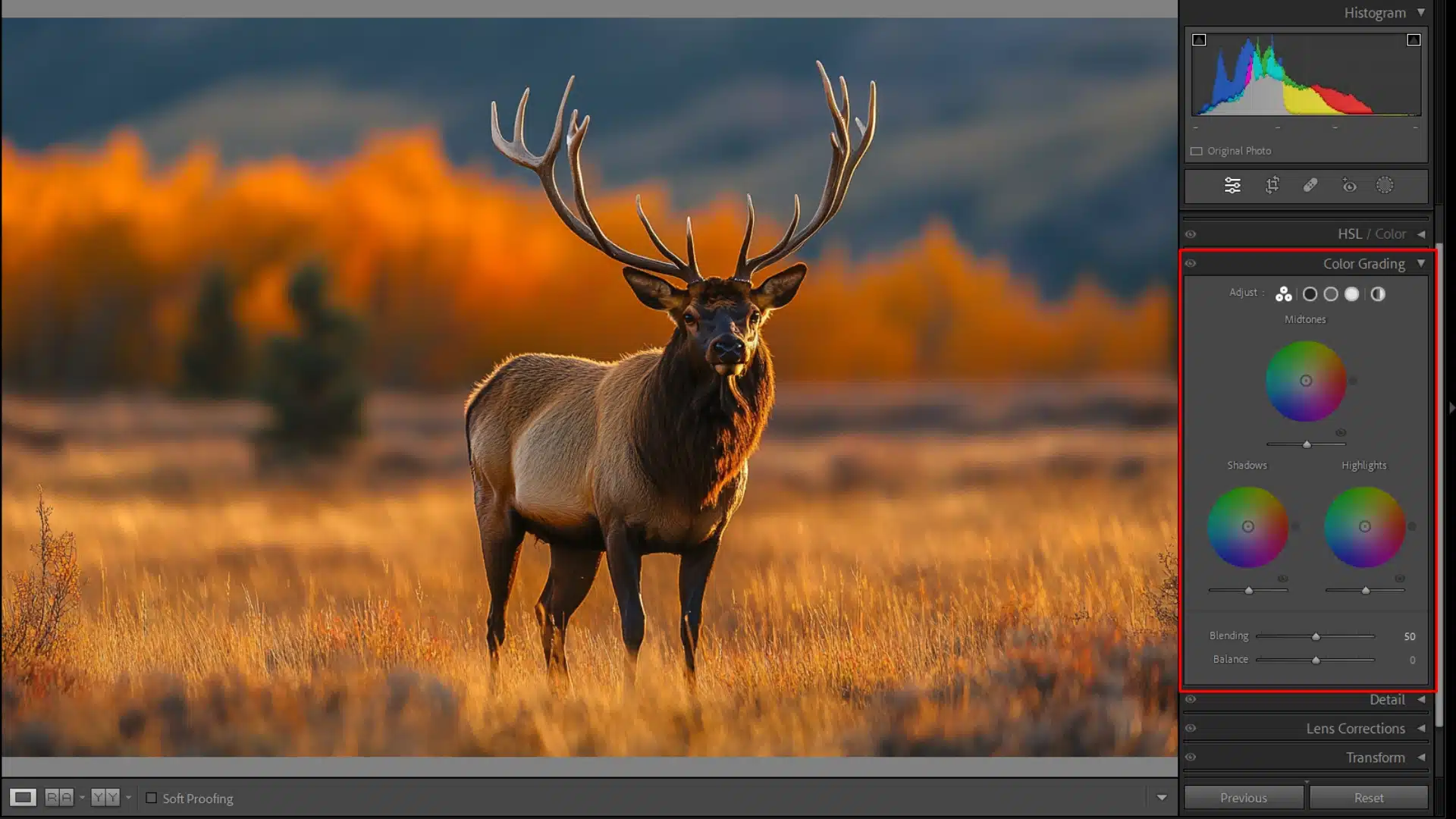
Color grading is a crucial step in wildlife photography post-processing, allowing you to increase the mood, atmosphere, and overall impact of your images. Proper color grading can transform a good photo into a stunning piece of art that stands out in your portfolio. Here’s how you can effectively color grade your wildlife photos using tools like Adobe Lightroom.
| Tool/Technique | Purpose | Best Application |
|---|---|---|
| Hue, Saturation, Luminance (HSL) | Adjust color tones, intensity, and brightness. | Control individual colors, making greens more vibrant or skies more vivid. |
| Vibrance vs. Saturation | Enhance muted colors without overdoing saturation. | Preserve natural tones while intensifying subtle hues in wildlife images. |
| Curves | Modify tonal range and specific color channels (RGB). | Fine-tune color casts for desired mood, especially in shadows and highlights. |
| Color Grading Panel | Adjust shadows, midtones, and highlights independently. | Add warmth to highlights and cool tones to shadows for depth and atmosphere. |
| LUTs (Look-Up Tables) | Apply consistent color grading across images. | Create a cohesive look in your wildlife photography series. |
| Custom Profiles | Save custom color grading settings for future use. | Ensure consistency and signature style across your portfolio. |
Understanding the Basics of Color Grading
Before diving into specific tools, it’s important to understand the fundamentals of color grading:
- Hue, Saturation, and Luminance (HSL): These sliders allow you to control the color properties in your image. Hue adjusts the shade of colors (e.g., making greens more yellow or blue). Saturation controls the intensity of each color, and Luminance adjusts the brightness of specific colors.
- Vibrance vs. Saturation: Vibrance increases the intensity of more muted colors without oversaturating already vivid ones, making it ideal for wildlife images where you want to avoid unnatural, overly saturated tones.
- Curves: The Curves tool is powerful for both tonal and color adjustments. You can individually adjust the red, green, and blue channels to add or remove specific color casts, giving you precise control over the mood of your image.
Using Lightroom’s Color Grading Panel
The Color Grading Panel in Lightroom is where you can make detailed adjustments to the shadows, midtones, and highlights independently, which is essential for creating a balanced and dynamic look.
- Shadows: Adding cool tones (like blues) to the shades can create depth and a natural feel, particularly in images with a lot of greenery or water.
- Midtones: Adjusting the midtones is about enhancing the subject. Warmer tones often work well here to draw attention to the wildlife subject without affecting the overall balance of the image.
- Highlights: For highlights, adding warmer tones can give a natural sunlight effect, making your wildlife focus appear more vibrant and lively.
Advanced Techniques: LUTs and Custom Profiles
For more advanced color grading, consider using LUTs (Look-Up Tables) or creating custom profiles in Photoshop that can be imported into Lightroom:
- LUTs: These are presets that apply a specific color grading effect across your entire image. You can use them to quickly apply a cinematic look or to match the color palette of a series of images.
- Custom Profiles: You can create custom profiles by combining different adjustment layers in photoshop and saving them as a LUT. This custom profile can then be applied to other images in Lightroom, ensuring consistency across your portfolio.
Avoiding Common Pitfalls
While color grading can significantly increase your images, it’s easy to overdo it. Here are some tips to avoid common mistakes:
- Subtle Adjustments: Make subtle adjustments, especially with vibrance and saturation, to avoid making your images look unnatural or overly processed.
- Before and After Comparison: Regularly compare your graded image with the original to ensure you’re enhancing, not detracting from, the natural beauty of the scene.
- Balancing Colors: Ensure that your color grading does not overpower the image. The goal is to complement the focus and setting, not to distract from them.
By mastering these color grading techniques, you can create wildlife images that not only capture the beauty of the natural world but also resonate emotionally with your audience. These refined, carefully graded images will be the highlight of any wildlife photography portfolio.
Common Questions about Editing Wildlife Photos in Lightroom

How to edit wildlife in Lightroom?
Editing wildlife photos in Lightroom involves several key steps. Start by adjusting the White Balance to ensure accurate color representation, which is critical for natural-looking wildlife shots. Next, fine-tune Exposure settings to balance the highlights and shadows, particularly if your subject is backlit or in challenging lighting conditions. Use the HSL (Hue, Saturation, and Luminance) panel to control specific colors, ensuring that the colors of the animals and their environment are vibrant but realistic. Finally, employ local adjustments to selectively increase details such as the animal’s eyes or fur, helping the subject stand out against the background.
What is the best way to edit wildlife photos?
The best way to edit wildlife photos is to adopt a workflow that enhances the natural beauty of your images while maintaining realism. Begin with basic adjustments like White Balance, Exposure, and Contrast to correct the overall look of the image. Then, move on to color grading using tools like the HSL panel and Color Grading panel to refine colors, making them pop without looking artificial. For finer control, use local adjustments to emphasize the subject, such as enhancing the eyes or sharpening the fur. Finally, apply noise reduction if necessary, and finish with subtle sharpening to bring out the details.
What is the best wildlife photo editing software?
Should you edit wildlife photos?
Yes, you should edit wildlife photos to enhance their visual impact and correct any imperfections that might have occurred during shooting. Editing allows you to adjust, color, and sharpness, ensuring that your wildlife photos accurately reflect the scene you intended to capture. However, it’s important to edit wildlife photos with a light touch to maintain the natural appearance of the wildlife and their environment. Over-editing can lead to unnatural results, so aim for edits that enhance without distorting reality.
Conclusion: Editing Wildlife Photos in Lightroom
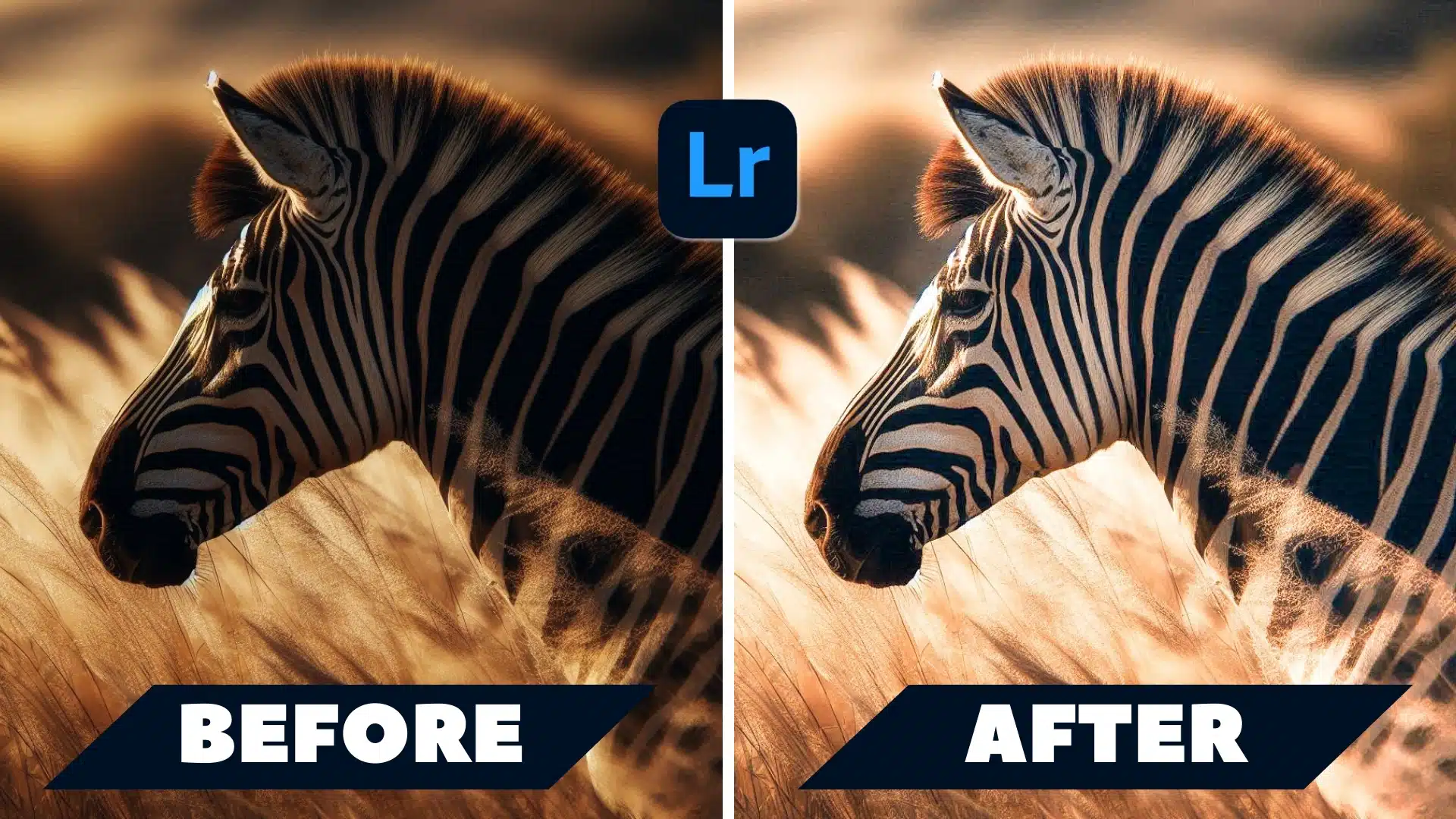
This process reveals the hidden beauty in wildlife photography by editing wildlife photos in Lightroom. To enhance your skills, explore our Photoshop course or Lightroom course today.
If Editing Wildlife Photos in Lightroom article has helped you, then Like and Share it with your friends
Have a nice photoshoot!
Read more about: Photo Editing with Lightroom and Photoshop








